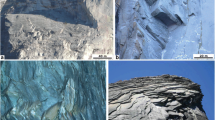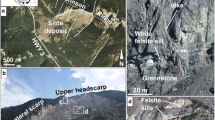Abstract
Terrestrial laser scanning (TLS) monitoring has been used to estimate the location, volume, and kinematics of a variety of small magnitude rockfalls before failure (1–1000 m3 range), and in some cases, potential failure time has been assessed through the application of inverse velocity methods. However, our current understanding of rock slope pre-failure behavior for this magnitude range and prediction ability is based on observations of a small number of failure case histories. In this study, a pre-failure deformation database was constructed for rockfall volumes exceeding 0.1 m3, observed over a 1252-day study interval at the Goldpan rock slope, British Columbia, Canada, in order to better understand the pre-failure behavior of rock slopes and provide an empirical means of estimating temporal failure ranges. Repeated TLS datasets were acquired at an average scanning interval of 2–3 months. A total of 90 rockfall events were recorded at this site, during this time period, of which 64 (71%) exhibited measurable deformation prior to failure. Classification of rockfalls by volume suggests that a scale dependency may exist, as deformation was detected for a greater proportion of rockfalls > 5 m3 (92%) than for smaller rockfalls in the range of 0.1–0.5 m3 (61%). A lower rate of pre-failure deformation detection was also reported for planar sliding failures as compared with wedge or toppling failures, suggesting that deformation was less easily detected for these failure types. This study proposes and implements a framework for rockfall assessment and forecasting that does not require continuous monitoring of deformation.













Similar content being viewed by others
References
Abellán A, Jaboyedoff M, Oppikofer T, Vilaplana JM (2009) Detection of millimetric deformation using a terrestrial laser scanner: experiment and application to a rockfall event. Nat Hazards Earth Syst Sci 9(2):365–372. https://doi.org/10.5194/nhess-9-365-2009
Abellán A, Calvet J, Vilaplana JM, Blanchard J (2010) Detection and spatial prediction of rockfalls by means of terrestrial laser scanner monitoring. Geomorphology 119(3-4):162–171. https://doi.org/10.1016/j.geomorph.2010.03.016
Barton N (1973) Review of a new shear-strength criterion for rock joints. Eng Geol 7(4):287–332. https://doi.org/10.1016/0013-7952(73)90013-6
Besl PJ, McKay ND (1992) A method for registration of 3-D shapes. IEEE Transactions on pattern analysis and machine intelligence, 14(2), 239–256
Crosta GB, Agliardi F (2003) Failure forecast for large rock slides by surface displacement measurements. Can Geotech J 40(1):176–191. https://doi.org/10.1139/t02-085
Dewez T, Rohmer J, Regard V (2013) Probabilistic coastal cliff collapse hazard from repeated terrestrial laser surveys: case study from Mesnil Val (Normandy, northern France). J Coast Res 65:702–777. https://doi.org/10.2112/SI65-119.1
Frayssines M, Hantz D (2006) Failure mechanisms and triggering factors in calcareous cliffs of the Subalpine Ranges (French Alps). Eng Geol 86(4):256–270. https://doi.org/10.1016/j.enggeo.2006.05.009
Fukuzono T (1985) A new method for predicting the failure time of a slope. Proceedings of the 4th International Conference and Field Workshop in Landslides, Tokyo (pp. 145–150)
Goodman RE, Bray JD (1976) Toppling of rock slopes. In: Proceedings of the Specialty Conference on Rock Engineering for Foundations and Slopes ASCE, Boulder, Colorado, 15–18
Goodman RE, Shi G-H (1985) Block theory and its application to rock engineering. Prentice Hall, Upper Saddle River
Government of Canada (2017) Environment Canada Historical Data. Available from http://climate.weather.gc.ca/climate_data/daily_data_e.html?StationID=51598&timeframe=2&StartYear=1840&EndYear=2017&Day=1&Year=2017&Month=3#
Guerin A, Hantz D, Rossetti JP (2014) Brief communication “Estimating rockfall frequency in a mountain limestone cliff using terrestrial laser scanner”. Nat Hazards Earth Syst Sci Discuss 2(1):123–135. https://doi.org/10.5194/nhessd-2-123-2014
Guzzetti F, Reichenbach P, Wieczorek GF (2003) Rockfall hazard and risk assessment in the Yosemite Valley, California, USA. Nat Hazards Earth Syst Sci 3:491–503
Hantz D, Vengeon JM, Dussauge-Peisser C (2003) An historical, geomechanical and probabilistic approach to rock-fall hazard assessment. Nat Hazards Earth Syst Sci 3(6):693–701. https://doi.org/10.5194/nhess-3-693-2003
Hoek E, Bray JD (1981) Rock slope engineering, 3rd edn. Taylor & Francis Group, New York
Hungr O, Evans SG, Hazzard J (1999) Magnitude and frequency of rock falls and rock slides along the main transportation corridors of southwestern British Columbia. Can Geotech J 36(2):224–238. https://doi.org/10.1139/t98-106
InnovMetric 2014 PolyWorks V14. Quebec City, Canada
Ishikawa M, Kurashige Y, Hirakawa K (2004) Analysis of crack movements observed in an alpine bedrock cliff. Earth Surf Process Landf 29(7):883–891. https://doi.org/10.1002/esp.1076
Kromer R, Abellán A, Hutchinson D, Lato M, Edwards T, Jaboyedoff M (2015a) A 4D filtering and calibration technique for small-scale point cloud change detection with a terrestrial laser scanner. Remote Sens 7(10):13029–13052. https://doi.org/10.3390/rs71013029
Kromer RA, Hutchinson DJ, Lato MJ, Gauthier D, Edwards T (2015b) Identifying rock slope failure precursors using LiDAR for transportation corridor hazard management. Eng Geol 195:93–103. https://doi.org/10.1016/j.enggeo.2015.05.012
Kromer R, Lato MJ, Hutchinson DJ, Gauthier D, Edwards T (2017) Managing rockfall risk through baseline monitoring of precursors with a terrestrial laser scanner. Can Geotech J 54(7):953–967. https://doi.org/10.1139/cgj-2016-0178
Lague D, Brodu N, Leroux J (2013) Accurate 3D comparison of complex topography with terrestrial laser scanner: application to the Rangitikei canyon (N-Z). ISPRS J Photogramm Remote Sens 82:10–26. https://doi.org/10.1016/j.isprsjprs.2013.04.009
Lato M, Hutchinson J, Ball D, Harrap R (2009) Engineering monitoring of rockfall hazards along transportation corridors: using mobile terrestrial LiDAR. Nat Hazards Earth Syst Sci 9(3):935–946. https://doi.org/10.5194/nhess-9-935-2009
Lim M, Petley DN, Rosser NJ, Allison RJ, Long AJ, Pybus D (2005) Combined digital photogrammetry and time-of-flight laser scanning for monitoring cliff evolution. Photogramm Rec 20(110):109–129. https://doi.org/10.1111/j.1477-9730.2005.00315.x
Luckman BH (1976) Rockfalls and rockfall inventory data: some observations from surprise valley, Jasper National Park, Canada. Earth Surf Process Landf 1(3):287–298. https://doi.org/10.1002/esp.3290010309
Norrish NI, Wyllie DC (1996) Chapter 15: rock slope stability analysis. In: Turner AK, Schuster RL (eds) Landslides: investigation and mitigation., Transportation Research Board Special Report 247. National Academy Press, Washington, D.C., pp 391–425
Oppikofer T, Jaboyedoff M, Blikra L, Derron M-H, Metzger R (2009) Characterization and monitoring of the Åknes rockslide using terrestrial laser scanning. Nat Hazards Earth Syst Sci 9(3):1003–1019. https://doi.org/10.5194/nhess-9-1003-2009
Rocscience (2017) Dips 7.0. Available from https://www.rocscience.com/rocscience/products/dips
Rosser NJ, Petley DN, Lim M, Dunning SA, Allison RJ (2005) Terrestrial laser scanning for monitoring the process of hard rock coastal cliff erosion. Q J Eng Geol Hydrogeol 38(4):363–375. https://doi.org/10.1144/1470-9236/05-008
Rosser N, Lim M, Petley D, Dunning S, Allison R (2007) Patterns of precursory rockfall prior to slope failure. J Geophys Res 112:F04014. https://doi.org/10.1029/2006JF000642
Royán MJ, Abellán A, Jaboyedoff M, Vilaplana JM, Calvet J (2013) Spatio-temporal analysis of rockfall pre-failure deformation using terrestrial LiDAR. Landslides 11(4):697–709. https://doi.org/10.1007/s10346-013-0442-0
Royán MJ, Abellán A, Vilaplana JM (2015) Progressive failure leading to the 3 December 2013 rockfall at Puigcercós scarp (Catalonia, Spain). Landslides 12(3):585–595. https://doi.org/10.1007/s10346-015-0573-6
Santana D, Corominas J, Garcia-Sellés D, Mavrouli O (2012) Magnitude–frequency relation for rockfall scars using a terrestrial laser scanner. Eng Geol 145-146:50–64. https://doi.org/10.1016/j.enggeo.2012.07.001
Schiarizza P, Church N (1996) The geology of the Thompson-Okanagan mineral assessment region (east part). Minist Energy Mines: OF1996–20. http://www.empr.gov.bc.ca/Mining/Geoscience/PublicationsCatalogue/OpenFiles/1996/Pages/1996-20.aspx
Stock GM, Martel SJ, Collins BD, Harp EL (2012) Progressive failure of sheeted rock slopes: the 2009–2010 Rhombus Wall rock falls in Yosemite Valley, California, USA. Earth Surf Process Landf 37(5):546–561. https://doi.org/10.1002/esp.3192
Sturzenegger M, Keegan T, Wen A, Wilms D, Stead D, Edwards T (2014) LiDAR and discrete fracture network modeling for rockslide characterization and analysis. In: Lollino G, Giordan D, Thuro K et al (eds) Engineering geology for society and territory-volume 6. Springer International Publishing, Cham, pp 223–227
Varnes DJ (1983) Time-dependent deformations in creep to failure of earth materials, In: Proc. 7th East Asian Geotechnical Conf., 2, 107–130, Southeast Asian Geotechnical Society, Bangkok
van Veen M, Hutchinson DJ, Kromer R, Lato M, Edwards T (2017) Effects of sampling interval on the frequency-magnitude relationship of rockfalls detected from terrestrial laser scanning using semi-automated methods. Landslides 9(5):1–14. https://doi.org/10.1007/s10346-017-0801-3
Wieczorek GF (1996) Chapter 4: landslide triggering mechanisms. In: Turner AK, Schuster RL (eds) Landslides: investigation and mitigation., Transportation Research Board Special Report 247. National Academy Press, Washington, D.C., pp 76–90
Acknowledgements
We thank David Bonneau, Richard Carter, Matthew Ondercin, and Megan van Veen of the Geomechanics Group at Queen’s University for aid in field data collection.
Funding
The authors would like to thank CN Rail for their generous technical and financial contributions as well as assistance offered during data collection campaigns. The overall funding for this project is provided by NSERC with financial support by CN Rail and Canadian Pacific. Last author also acknowledges funding from H2020 program of the European Commission [MSCA-EF 705215].
Author information
Authors and Affiliations
Corresponding author
Electronic supplementary material
ESM 1
(XLSX 16 kb).
Rights and permissions
About this article
Cite this article
Kromer, R.A., Rowe, E., Hutchinson, J. et al. Rockfall risk management using a pre-failure deformation database. Landslides 15, 847–858 (2018). https://doi.org/10.1007/s10346-017-0921-9
Received:
Accepted:
Published:
Issue Date:
DOI: https://doi.org/10.1007/s10346-017-0921-9




